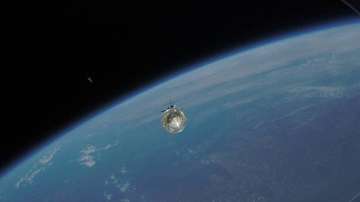NASA's "supersonic parachute" that will play a key role in landing its state-of-the-art Mars 2020 rover has created a world record by deploying in just four-tenths of a second and surviving 37,000 kg load, the US space agency said.
Less than two minutes after the launch of a 17.7-metre Black Brant IX sounding rocket, a payload separated and began its dive back through Earth's atmosphere, NASA said in a statement.
When onboard sensors determined the payload had reached the appropriate height (38 kilometers altitude) and Mach number 1.8, the payload deployed a parachute, it said.
Within four-tenths of a second, the 180-pound parachute billowed out from being a solid cylinder to being fully inflated.
According to NASA, it was the fastest inflation in history of a parachute this size and created a peak load of almost 70,000 pounds of force.
The mass of nylon, Technora and Kevlar fibre that make up the parachute will play an integral part in landing NASA's state-of-the-art Mars 2020 rover on the Red Planet in February 2021.
The Jet Propulsion Laboratory's (JPL) Advanced Supersonic Parachute Inflation Research Experiment (ASPIRE) project conducted a series of sounding rocket tests to help decide which parachute design to use on the Mars 2020 mission.
Two different parachutes were evaluated during ASPIRE. The first test flight carried almost an exact copy of the parachute used to land NASA's Mars Science Laboratory successfully on the red planet in 2012.
The second and third tests carried chutes of similar dimensions but reinforced with stronger materials and stitching.
"Mars 2020 will be carrying the heaviest payload yet to the surface of Mars, and like all our prior Mars missions, we only have one parachute and it has to work," said John McNamee, project manager of Mars 2020 at JPL.
The 37,000-kilogramme load was the highest ever survived by a supersonic parachute. That's about an 85-per cent higher load than what scientists would expect the Mars 2020 parachute to encounter during its deployment in Mars' atmosphere.
"Earth's atmosphere near the surface is much denser than that near the martian surface, by about 100 times," said Ian Clark, the test's technical lead from JPL.
"But high up -- around 37 kilometers -- the atmospheric density on Earth is very similar to 10 kilometers above Mars, which happens to be the altitude that Mars 2020 will deploy its parachute," Clark said.

